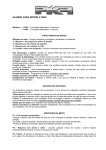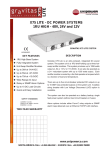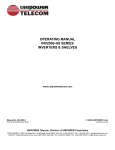Download Unipower Gravitas X100 Specifications
Transcript
Price: $25.00 OPERATING MANUAL X100 COMPACT, INTEGRATED DC POWER SYSTEM Manual No. X100-203-1 X100-Man-revA-11-26-03.p65 © copyright 2003 UNIPOWER Corp. All Rights Reserved UNIPOWER Telecom, Division of UNIPOWER Corporation 2633065, UNITED STATES • Tel: 954-346-2442 • Fax: 954-340-7901 • [email protected] DIV. OF UNIPOWER CORP. • 3900 Coral Ridge Drive, Coral Springs, Florida UNIPOWER EUROPE • Parkland Business Centre, Chartwell Road, Lancing, BN15 8UE, ENGLAND • Tel: +44(0)1903 768200 • Fax: +44(0)1903 764540 • [email protected] ILLUSTRATIONS FIGURE 1 2 3 4 5 TITLE PAGE Gravitas X100 Compact, Integrated DC Power System Gravitas X100 with Connections Gravitas X100 Integral Controller Gravitas X100 Simplified Block Diagram Gravitas X100 Signal Interface Connections 27 2 7 9 9 13 CONTENTS SECTION TOPIC PAGE 1.0 2.0 3.0 4.0 5.0 6.0 7.0 Introduction General Description Gravitas X100 Summary Features Summary of X100 System Capability Rectifier Summary and Specifications Power Distribution Section Controller Section 8.0 9.0 Safety Warnings and Precautions Warranty 10 10 Unpacking and Inspection Description of Operation Installation Introduction to Control and Monitoring Integral Controller Front Panel Description Signal Input/Output Connections Integral Controller LED Indicators Front Panel Adjustment Potentiometers Description of Controller Operation Controller Signal Connections Battery Temperature Compensation (Option) Alarm Enabling Voltage and Current Measurements Maintenance Gravitas X100 Data Sheet 11 11 12 15 15 16 16 16 17 18 20 21 21 21 A1 10.0 11.0 12.0 13.0 14.0 15.0 16.0 17.0 18.0 19.0 20.0 21.0 22.0 23.0 Appendix 1 28 1 1 3 4 4 6 8 OPERATING MANUAL GRAVITAS X100 COMPACT, INTEGRATED DC POWER SYSTEM 1.0 INTRODUCTION This Operating Manual should be read through carefully before installing and operating the Gravitas X100 Integrated DC Power System. Connection to this system and servicing it must be performed only by qualified technicians who are trained in the installation and operation of electrical power systems. The safety warning described later must be carefully followed. Unipower Telecom, a division of Unipower Corporation, does not accept responsibility for safety, reliability or performance of these systems if any modifications or repairs are carried out by unauthorized personnel. Unipower Telecom specified replacement parts must be used and must be of the same type and rating to ensure continued protection against risk of fire. Since Unipower Telecom has a policy of continued product improvement, specifications and components of this system are subject to change. 2.0 GENERAL DESCRIPTION 2.1 The Gravitas X100 is a compact, integrated DC power system. See Figure 1. It consists of three high power-density, hot-swap rectifier modules which can produce a total 60 amperes at -48VDC, 99 amperes at +24VDC, or +12V at 100A depending on system configuration. In a 2+1 redundant operation the output currents are 40, 66 and 50 amperes, respectively. There are three standard models of the X100. 2.2 The complete system has a DC distribution panel with up to 5 load circuits which are protected by circuit breakers, GMT fuses or a combination of the two. Optional is a low-voltage battery disconnect. Battery breakers for up to two battery strings can be provided. 1 SYSTEM FRONT VIEW æ æ æ 1 1 3 2 2 4 GMT FUSES CONTROLLER SECTION æ æ DC LOAD BREAKERS æ BATTERY STRING BREAKER(S) 1 4 æ 2RU æ 1 2 3 Figure 1. Gravitas X100 Compact, Integrated DC Power System 2 RECTIFIER MODULES 3.0 2.3 The integral controller has LED visual alarms, Form C relay alarms, test points and set-point adjustments including over- and under-voltage adjustments. There is a temperature compensation option. 2.4 The complete Gravitas X100 is only 2RU high (3.47 inches or 88.1mm) and is easily installed by a qualified technician. All connections are at the rear to DIN-rail terminal blocks. The units may be mounted in 19- or 23-inch racks. See Figure 2. GRAVITAS X100 SUMMARY FEATURES u u u u u u u u u u u u u u u u Choice of Hot-Swap Rectifiers 120 or 230VAC Input Power Factor Corrected Class B EMI Input Filter Up to 60A at -48VDC Up to 99A at +24VDC Up to 100A at +12VDC Up to 4 DC Circuit Breakers plus GMT Fuses Up to 2 Battery Strings Up to 2 Battery String Breakers LV Battery Disconnect Option Integral Controller Quick, Easy Installation Modular Design Only 2RU (3.47 Inches) High Only 11.56 Inches (294mm) Deep 3 4.0 SUMMARY OF X100 SYSTEM CAPABILITY Table 4-1 summarizes the Gravitas X100 overall capability for the three standard models. Table 4-1 X100 System Capability SYSTEM CAPABILITY SYSTEM CAPABILITY System Voltage System Max. Current System Current, 2+1 Input Range, VAC Rectifier Model Rectifiers Required, max. Battery String Breakers Low Voltage Disconnect1 Total No. of DC Loads, max.2 1A-50A Breakers (standard) 1A-20A Breakers (standard) ½A-12A GMT Fuses (option) Control Features Alarm Outputs Temp. Compensation Rack Height Rack Width, Inches3 NOTES: 5.0 X100-48P/60 X100-24P/100 X100-12P/100 -54.4VDC 60A 40A 85-264 RPCP48/20 3 1 standard optional 5 2 2 4 +27.2VDC 99A 66A 85-264 RPCP24/33 3 2 standard optional 5 2 2 4 +13.6VDC 100A 50A 85-264 RPCP12/50 2 2 standard optional 5 2 2 4 4 standard optional 2RU 19 4 standard optional 2RU 19 4 standard optional 2RU 19 1. Battery disconnect. 2. Up to 4 loads standard. Up to 5 loads with combination of breakers and optional GMT fuses. 3. 23-Inch mounting brackets can be supplied. RECTIFIER SUMMARY & SPECIFICATIONS 5.1 The Gravitas X100 rectifiers consist of two or three parallel-connected, hot-swap rectifier modules. There is a choice of three different modules which give the following maximum system capabilities: -48VDC at 60 amperes, +24VDC at 99 amperes and +12VDC at 100amperes. One rectifier can be used for redundancy with lower system output. 5.2 The -48, +24 and +12 volt outputs are nominal values. The actual adjustment ranges are 45 to 58V, 22.5 to 29V, and 11 to 14.5 respectively; the factory-set outputs are -54.4V, +27.2V, amd 13.6V respectively. Table 5-1 summarizes the key characteristics of the three rectifier module models. 4 Table 5-1 Rectifier Module Summary MODULE MODEL NO. SPECIFICATIONS Output Voltage, Nom. Output Voltage, Set Output Voltage Range Output Current, Max. Output Watts, Max. Input Range, VAC Input Power Factor Input Current, 230VAC 120VAC Inrush Current Limit Input Frequency, Hz Efficiency Total Regulation, Max. 5.3 RPCP48/20 RPCP24/33 RPCP12/50 48VDC 24VDC 12VDC 54.4V 27.2V 13.6V 45-58V 22.5-29V 11-14.5V 20A 33A 50A 1,088 898 680 85-264 85-264 85-264 0.99 0.99 0.99 5.6A 5.6A 5.6A 10.8A 10.8A 10.8A 50A Pk. 50A Pk. 50A Pk. 47-63 47-63 47-63 87% 85% 82% 2.0% 2.0% 2.0% Table 5-2 gives the detailed specifications of the rectifier modules. Table 5-2 Rectifier Module Specifications INPUT Voltage Range _______________________ 85-264 or 170-264VAC Power Factor _______________________________________ 0.99 Total Harmonic Distortion, Max. _________________________ 5% Frequency _______________________________________ 47-63Hz Inrush Current Limiting ___________________________ 50A Peak EMI Filter, Conducted ______________ FCC20780 pt. 15J Curve B _____________________ EN55022 Curve B Input Immunity, Conducted Fast Transients, Line-Line _________ ±2kV (EN61000-4-4 Level 3) Surges, Line-Line ________________ ±1kV (EN61000-4-5 Level 2) Surges, Line-Ground _____________ ±2kV (EN61000-4-5 Level 3) OUTPUT Output Voltage Set, 48V Nom. _____________________ 54.4VDC 24V Nom. _____________________ 27.2VDC 12V Nom. _____________________ 13.6VDC Voltage Adjustment Range, 48V Nom. ______________ 45-58VDC 24V Nom. _____________ 22.5-29VDC 12V Nom. _____________ 11-14.5VDC Total Regualtion, Max. ______________________________ 1.0% Holdup Time ____________________________________ 20msec. Overvoltage Protection, 48V Out _______________________ 58V 24V Out _______________________ 29V 12V Out ______________________ 14.5V 5 Filtering: Wideband Noise, 20Mhz BW 48V Out, P-P __________________________________ 500mV 24V Out, P-P __________________________________ 250mV 12V Out, P-P __________________________________ 125mV Voice Band Noise ______________________________ <32dBrnC Current Limit __________________________ 105% Rated Current Efficiency _______________________________________ 82-87% STATUS INDICATORS AC Good ______________________________________ Green LED DC Good ______________________________________ Green LED ENVIRONMENTAL Operating Temp. Range ________________________ 00C to +700C Output Current Derating ______________ 2.5%/0C, 500C to 700C Storage Temp. Range _______________________ -400C to + 850C Humidity _______________________ 0% to 95%, Non-Condensing ESD _________________ Bellcore GR-1089-Core and EN61000-4-2 Cooling ____________________________________ Internal Fans 6.0 POWER DISTRIBUTION SECTION 6.1 Figure 1 shows the top section of the system showing two battery circuit breakers (one standard in the 48V model, two standard on the 24 and 12V models). These battery breakers are rated at 80A each. Next are up to two load breakers rated 1A to 50A in positions 1 and 2 followed by two additional load breakers rated at 1A and 20A in postions 3 and 4. An optional 4 (active) position GMT fuse block rated up to 15A each. 6.2 The total number of DC load circuits is five. This means any combination of up to five breakers and fuses are available. 6.3 The DC distribution connections are made at the rear of the X100 to DIN-Rail terminal blocks. See Figure 2. 6 SYSTEM REAR VIEW æ æ J2 BAT 2 IN BAT 1 IN æ æ J1 æ 1A-20A 1A-50A LOAD LOAD TERMINALS TERMINALS æ ALARMS, FORM C OUTPUTS AND TEMP. COMP. DEPTH: 11.56 (294mm) 3.47 (88.1) ALL DIMENSIONS IN INCHES (mm). All specifications subject to change without notice. æ æ Figure 2. Gravitas X100 Connections 7 æ 3 2 1 AC INPUT 17.19 (437) 7.0 CONTROLLER SECTION 7.1 Integral Controller. This controller controls the system rectifier, monitors the system parameters and has alarms for system failures. See Figure 3. There are eight red LED alarms and four Form C relay outputs to indicate a failure: ◆ ◆ ◆ ◆ ◆ ◆ ◆ ◆ Rectifier-Fail Rectifier-Major Rectifier-Minor AC Input Circuit Breaker or Fuse Low Voltage Disconnect Overvoltage Undervoltage Four front-panel voltage-set adjustments are for: ◆ Float Voltage ◆ Battery Overvoltage ◆ Battery Undervoltage ◆ Temperature Compensation Test points for load voltage and current permit external measurement of these values. 7.2 Low-Voltage Battery Disconnect (Option). This battery disconnect has a 100-ampere capacity and connects between the rectifier output bus and the battery. The contactor disconnects the battery from the rectifier and loads when the rectifier bus (and battery) voltage drops to 42.5V for a 48V system, 21.25V for 24V system or 10.6V for a 12V system. When the rectifier bus voltage rises above 49V for a 48V system, 24.5V for a 24V system, or 12.3V for a 12V system, the contactor reconnects the battery to the rectifier bus. 8 Figure 3. Integral Controller Figure 4. Gravitas X100 Simplified Block Diagram 9 8.0 9.0 SAFETY WARNINGS AND PRECAUTIONS 8.1 This Integrated Power System must be handled, installed and maintained only by qualified technical persons who are trained in the installation and use of power systems and are well aware of the hazards involved with these systems. 8.2 WARNING: This power system has hazardous external and internal voltages; the system also has high earth leakage current. The AC input voltage of 85 to 264VACis hazardous, and the output voltages of 45 to 58VDC, 22.5 to 29VDC and 11 to 14.5VDC are hazardous. Touching either input or output terminals while the system is connected and operating could cause serious injury or death. Internal assemblies are also hazardous and should not be touched. 8.3 Covers on internal assemblies should not be removed. There are no user-serviceable components in these assemblies. Removing the covers of these assemblies will void the warranty. 8.4 Installation connections should be made without input power applied, without battery power applied and without other power sources applied to the load. 8.5 The chassis should be connected to the system frame ground terminal and a three-wire AC power line with ground connection should be used to minimize electrical shock hazard and ensure low EMI (electromagnetic interference). 8.6 This operating manual should be read carefully and understood before attempting installation or testing. WARRANTY All products of UNIPOWER Telecom, a division of UNIPOWER Corporation, are warranted for two (2) years from date of shipment against defects in material and workmanship. This warranty does not extend to products which have been opened, altered or repaired by persons other than persons authorized by the manufacturer or to products which become defective due to acts of God, negligence or the failure of customer to fully follow instructions with respect to installation, application or maintenance. This warranty is extended directly by the manufacturer to the buyer and is the sole warranty applicable. EXCEPT FOR THE FOREGOING EXPRESS WARRANTY, THE MANUFACTURER MAKES NO WARRANTY, EXPRESS OR IMPLIED, INCLUDING, BUT NOT LIMITED TO, THE WARRANTY OF MERCHANTABILITY OR FITNESS FOR A PARTICULAR PURPOSE. As the sole and exclusive remedy under this warranty, the manufacturer, at its option, may repair or replace the non-conforming product or issue credit, provided the manufacturer’s inspection establishes the existence of a defect. To exercise this remedy, the buyer must contact the manufacturer’s Customer Service Department to obtain a Return Material Authorization number and shipping instructions. Products returned without prior authorization will be returned to buyer. All products returned for repair must be shipped freight prepaid to UNIPOWER. If the buyer fails to fully comply with the foregoing, the buyer agrees that no other remedy (including, but not limited to, incidental or consequential damages for lost profits, lost sales, injury to person or property or any other incidental or consequential losses) shall be available to the buyer. 10 10.0 11.0 UNPACKING AND INSPECTION 10.1 This Gravitas X100 Integrated DC Power System was carefully tested, inspected and packaged for shipment from our factory. Upon receipt of the unit it should be carefully unpacked and inspected for any damage in shipment. 10.2 If there is evidence of damage, do not attempt to install the unit. The freight carrier should be notified immediately and a claim for the cost of the system should be filed with the carrier for direct reimbursement. Be sure to include the model and serial number of the damaged unit in all correspondence with the freight carrier. Also save the shipping carton and packing material as evidence of damage for the freight carrier’s inspection. 10.3 UNIPOWER Telecom will cooperate fully in case of any shipping damage investigation. 10.4 Always save the packing materials for later use in shipping the unit. Never ship the rectifier system without proper packing. DESCRIPTION OF OPERATION 11.1 Block Diagram. A simplified block diagram of the Gravitas X100 is shown in Figure 4. 11.2 Operation. The AC input of 120 or 230VAC (Fig. 4) goes to each rectifier through individual IFC line card entries. Optional terminal block are GMT filtered out are avaialble. The input of each module has power factor correction resulting in a pure factor near unity. The outputs of the modules are connected in parallel with an ORing diode in the output of each rectifier. This allows rectifier module to be hot-swapped without disturbing the output voltage. The -48, +24VDC or +12VDC output goes through the LVD contactor and the battery circuit breaker to the battery. The output also goes to the load circuit breakers and then to each load. If the rectifier bus voltage drops below 42.5VDC for a -48 system or 21.25VDC for a +24V system, and 10.6VDC for a +12V system. the LVD contactor opens and disconnects the battery from the system output. This generally happens when there is a failure in the AC input to the rectifiers. When AC input is restored and the rectifier bus voltage rises above 49.0VDC for a -48V system, 24.5VDC for a +24V system, and 12.3VDC for a +12V system the LVD contactor closes again. 11 11.3 12.0 Control and Monitoring. The integral controller has inputs from and outputs to each rectifier module. The inputs let the controller monitor the operation of each rectifier module and detect failure if it occurs. The outputs to the rectifier modules let the controller control the module output voltage. Likewise, there is an input and output from the Low Voltage Disconnect (LVD), an input from the battery and an input from each load breaker. These signals result in operation of the alarm LEDs and the Form C relay alarms. The controller also has digital meters to read the load voltage and current. A 50mV shunt is located in the rectifier bus to measure the load current. INSTALLATION 12.1 CAUTION: Re-read the Safety Warnings and Precautions in Section 8.0. All power should be OFF for the input and output loads before making connections. Connection of the X100 chassis to frame ground should be made first. If the X100 has been turned on before installation connections, it should be turned off and given a 5-minute waiting period for all internal energy storage capacitors to be discharged. 12.2 Input AC Power Connection. See Figure 2. An unplugged 3-wire AC power line should be connected into the input terminal blocks or plug IEC connectors. The line, neutral and ground connections should be carefully followed when making the AC connections. The AC line cable should be sized to safely carry 20 amperes AC. 12.3 Checking Outputs. Turn all output circuit breakers to the OFF position and/or remove all fuses from the GMT fuse-holder. With no loads connected and without the battery connected, plug in or connect the AC input cable to the power source. Be sure to use the correct AC voltage for the rectifier inputs. Observe the DC voltage reading on the test points on the controller panel. The voltage should be approximately 54.4, 27.2, or 13.6VDC (depending on model), which is the factory setting. The current test points should read zero. One by one, turn each output circuit breaker to the ON position and/or insert a GMT fuse and, using a digital voltmeter, measure the DC voltage across the corresponding output terminals. The voltage should again read approximately 54.4, 27.2, or 13.6 volts. After each output is measured, turn OFF that circuit breaker and/or remove the GMT fuse and turn ON and/or insert fuse in the next one. After measuring the last circuit, turn off that breaker and/or remove the GMT fuse and make sure that all output breakers are in the OFF position and/or all fuses are removed. Next, unplug or disconnect the AC input power source. Before touching any terminals wait 5 minutes for the internal storage capacitors to discharge. 12 INTERFACE CONNECTIONS J2 J1 PIN FUNCTION 1 2 3 4 5 6 7 8 9 10 11 12 MINA - NC MINA - C MINA - NO MAJA - NC MAJA - C MAJA - NO ACFA - NC ACFA - C ACFA - NO RFA - NC RFA - C RFA - NO PIN FUNCTION 1 2 3 4 5 6 7 8 9 10 11 12 DESCRIPTION Minor Alarm Output - NC Minor Alarm Output - C Minor Alarm Output - NO Major Alarm Output - NC Major Alarm Output - C Major Alarm Output - NO AC Fail Alarm Output - NC AC Fail Alarm Output - C AC Fail Alarm Output - NO Rectifier Fail Alarm Output - NC Rectifier Fail Alarm Output - C Rectifier Fail Alarm Output - NO DESCRIPTION — — — TCEN — TC(+) — TC(-) — RVADJ — S(-) Temperature Compensation Alarm Disable Input Temperature Compensation Probe (+) Input Temperature Compensation Probe (-) Input System Remote Voltage Adjust Input Control Common Output Figure 5. Gravitas X100 Signal Interface Connections 13 12.4 Controller Section Operation and Settings. At this point, before the final installation connections, read sections 13 through 21, covering the Control Panel operation. Next, go back to sections 19, 20 and 21 and make the signal connections, controller adjustments, temperature compensation adjustment and alarm enabling settings. WARNING: Remember to take precautions each time the system is turned on and also when connecting or disconnecting the battery. Remember that the battery has a hazardous voltage at its terminals. Also remember to allow 5 minutes for internal capacitors to discharge after disconnecting the AC input power and the battery. 12.5 Connection to Loads. With input AC power unplugged, the battery disconnected and no other power sources connected to the loads, make sure that all load circuit breakers are set to the OFF position and/or all GMT fuses are removed. See Figures 2 and 4. Connect load wires to each set of output terminals, one at a time. Note that the front panel breaker and fuse numbers directly correspond to the output terminal numbers. Be sure to connect the polarities correctly as shown in Figure 4. 12.6 Connection to Battery. With AC input unplugged, remove the three rectifier modules from the system chassis. Make sure all load circuit breakers are in the OFF position and/or all GMT fuses removed. Set the battery circuit breaker to the OFF position. Carefully connect the battery cables to the DIN-Rail battery terminals shown in Figure 2. while observing the correct polarity. WARNING: Improper polarity of the battery connection may damage the power system. Take precautions when installing the battery and note that the battery cables are “hot” (live). Set the battery circuit breaker to the ON position and observe the reading on the digital voltmeter on the controller panel or connected to the test points. It should indicate the voltage of the battery, approximately 48, 24, and 12VDC when charged. If the battery is connected with wrong polarity, there will be no reading on the test points. 14 12.7 System Turn-On. Perform the following operations: ◆ ◆ ◆ ◆ ◆ ◆ ◆ Put the battery circuit breaker in the OFF position Plug in the three rectifier modules Connect the AC power cable to the AC source Put the battery circuit breaker in the ON position Check the digital voltmeter reading for the correct voltage Set each load circuit breaker to the ON position and/or insert each fuse Note the reading on the controller panel test points. With all loads connected, the output current should not exceed rated system load for non-redundant operation. 13.0 INTRODUCTION TO CONTROL & MONITORING 13.1 The integral controller is a basic control and monitoring system for the X100 power system. It controls up to 3 rectifiers, precisely setting the float voltage on all rectifiers simultaneously. It monitors the battery voltage and current by means of front panel test points. See Figure 3. 13.2 Front panel LEDs indicate status and alarm conditions of the monitored functions. Front panel potentiometers permit easy adjustment of the various control voltages. Form C relays also indicate status and alarms. 14.0 INTEGRAL CONTROLLER FRONT PANEL DESCRIPTION 14.1 The panel has a green LED alarm CTR which is normally green but turns off upon failure of the Control and Monitor System. 14.2 The controller has four terminals V+, V-, I+, I- for reading amperes and volts, the load current and voltage, using external meters. The current test points use an internal 50mV shunt. See Figure 3. 14.3 Voltage adjustment potentiometers VF, OV, UV, and TC. See the definitions in section 17.0. 14.4 Finally, are the LED indicators: LVDA, FA, OVUVA, TCA, MAJA, RFA, MINA, and ACFA. See the definitions in section 16.0. 15 15.0 SIGNAL INPUT/OUTPUT CONNECTIONS See Figure 5. for location and description of input and output signals, including the alarm enable switches. The input and output signal connections are to spring-clamp terminal blocks. 16.0 INTEGRAL CONTROLLER LED INDICATORS Red LEDs. (Normally off, failure is red) These are failure alarms indicating the following: ◆ ◆ ◆ ◆ ◆ ◆ ◆ ◆ 17.0 LVDA: Low Voltage Disconnect Alarm FA: Failure on any circuit breaker or fuse in the DC distribution OVUVA: Battery Overvoltage or Undervoltage TCA: Temperature Compensation Alarm MAJA: Major Alarm RFA: Rectifier Fail Alarm MINA: Minor Alarm ACFA: AC Fail Alarm FRONT PANEL ADJUSTMENT POTENTIOMETERS There are four front panel adjustment potentiometers: ◆ ◆ ◆ ◆ VF: OV: UV: TC: Float Voltage set (12 turns) Battery Overvoltage set (single turn) Battery Undervoltage set (single turn) Temperature Compensation set (single turn) Note that Temperature Compensation is an option. 16 18.0 DESCRIPTION OF CONTROLLER OPERATION 18.1 The system controls and monitors up to three rectifier modules. This is accomplished by means of a control cable which connects between the rectifier section and controller. Through these connections the controller controls the rectifier output voltage which is preset by the VF (float voltage) adjustment potentiometer. 18.2 The Controller also monitors the AC input and DC output of each of the rectifiers and gives an LED warning and Form C relay contact alarm in case of failure of any one or more of the rectifier modules. 18.3 The Controller also monitors for alarms from the low voltage disconnect and circuit breaker panel. The alarm outputs are Form C relay contacts which can be used for remote or local system alarms. 18.4 Other alarm outputs are for battery overvoltage and battery undervoltage. These are also Form C relay contacts. 18.5 Battery voltage and current are also monitored by the controller. They are read by the front panel test points. When using the front panel test points with an external voltmeter, the system output voltage is read directly from the voltage test points. The current, however, is read as the voltage across the current test points which go to a 50mV shunt. A 50mV shunt voltage corresponds to 100 amperes which is the full scale current. This results in a voltage scale factor of 2 amperes per millivolt. 18.6 The controller initiates a Form C alarm when any one or more circuit breakers have tripped or GMT fuses have blown. 18.7 The controller senses the battery voltage and provides LVD (low voltage disconnect) drop-out and pick-up drive for the LVD contactor. 17 19.0 CONTROLLER SIGNAL CONNECTIONS 19.1 See Figure 5. Signal connections to the J1 and J2 spring-clamp terminal blocks should to be made with wire gauges no. 20-26 AWG. Insulation should be stripped 0.2” from wire end. Alarm signals are Form C relay contact alarms for the function given. “Normally Closed” (NC) means a “short” between this terminal and the Common (C) terminal when the function is operating properly with power applied. “Normally Open” (NO) means an “open” between this terminal and the Common (C) terminal when the function is operating properly with power applied. 19.2 Form C Alarm Outputs. ACRONYM RFA ACFA MINA MAJA 19.3 DESCRIPTION Rectifier Fail Alarm AC Fail Alarm Minor Alarm Major Alarm Alarm and Signal Setup. 19.31 General. All signals are preset at the factory, and these values are listed in the following sections. Where voltages are given, the first one is for a -48VDC system, the second for a +24V system, and the third for +12V system. 19.32 LVD Dropout and Pickup. The Low-Voltage Disconnect (LVD) is an option. The trip levels are factory set at -42.5, +21.25, or +10.6VDC dropout and -49.0, +24.5, or 12.3VDC pickup. These are not field adjustable. 19.33 Battery Float Voltage. The voltage is set at the factory at -54.4, +27.2 or +13.6VDC. If a different nominal value is required, do the following: Install all rectifiers in the system. Disconnect the battery and adjust the float voltage (VFL) potentiometer on front panel to the level required. Do not use the voltage adjustments on the front panel of the rectifier modules. ◆ Reconnect the battery. ◆ ◆ 18 19.34 Battery Overvoltage. The voltage across the battery where the overvoltage alarm trips is factory set at -57, +28.6, or +14.3VDC. If a different nominal value is required, do the following: ◆ ◆ ◆ ◆ ◆ ◆ ◆ Unplug all rectifiers, disconnect AC, disconnect all loads and the battery. With an external variable voltage supply rated 0-60VDC, connect it across one set of the output load terminals and turn on its associated circuit breaker on the front panel. Be sure to observe the correct polarity. Bring the voltage up to approximately -55V, +27.5 or +13.3VDC. Verify that alarm LED (OVUVA) is off. Verify that the alarm LED goes on when the voltage is adjusted to -57.1VDC ± 1%, +28.5VDC ± 1% or +14.3VDC ± 1%. Readjust the 0V potentiometer on the front panel to set at the desired level. Verify that the alarm LED goes red at the set point. 19.35 Battery Undervoltage. The voltage across the battery where the undervoltage alarm trips is factory set at -43.5VDC, +21.8VDC or + 10.9VDC. If a different value is required, do the following: ◆ ◆ ◆ ◆ ◆ Follow the same procedure as described above for overvoltage alarm setup. At -55V, +27.5V, or +13.8V verify the alarm LED (OVUVA) is off. It should turn red when the voltage is adjusted to -43.5 ± 1%, +21.8VDC ± 1%, or +10.9VDC ± 1% Readjust the UV potentiometer on the front panel to set at the desired level. Verify that the alarm LED goes red at the set point. 19.36 TC Input. This is the optional temperature compensation input from the temperature compensation probe that comes with this option. The probe is used to measure battery temperature which is used to control the output of the rectifier. There is no polarity reference for connecting the temperature probe. Connection of the probe is to pins 6 and 8 of J1. See Figure 4. See Section 20 for further details on temperature compensation. 19 20.0 BATTERY TEMPERATURE COMPENSATION (OPTION) 20.1 The temperature compensation option comes with a temperature probe and 20foot cable. The probe is a thermistor which is connected to J1 pins 6 and 8. There is no polarity for this connection. The probe is used to monitor the temperature of the battery and adjust the rectifier output voltage accordingly. As battery temperature increases, rectifier output voltage decreases. 20.2 The change in output voltage with temperature is -3.75mV/0C per battery cell, centered at 250C. For example, for a +100C temperature change from 250C with the rectifier charging a 48V battery, the change in the rectifier output voltage would be: 48 = 24 cells 2 V = 24 cells x 100C change x (-3.75mV/0C) = -900mV = -0.9V 20.3 The probe can be located in several possible places: right on the battery to detect the battery temperature, near the battery in free air to detect the local ambient temperature, or on the power plant metal frame near the battery. 20.4 If the TC probe is either opened or shorted, the rectifier outputs revert to the float voltage. 20.5 Setting the Temperature Compensation Voltage. 20.51 Make sure that the float voltage was set with the temperature probe disconnected. 20.52 Before connecting the temperature probe, record the float voltage to three digits. 20.53 Connect the temperature probe to terminals 6 and 8 of J1. 20.54 With the temperature probe at approximately 250C ambient temperature, adjust the front panel TC potentiometer until the rectifier output voltage as read on an external voltmeter is exactly the same as the previously recorded float voltage. 20 21.0 ALARM ENABLING 21.1 There is only one alarm function that requires enable: ◆ 21.2 22.0 23.0 TC Enable (TCEN): Remove jumper from J1 Pin 4 to J1 Pin 6 to enable the TC function. After making the signal connections, controller adjustments, temperature compensation adjustment and alarm enable settings of Sections 19 through 21, go back to Section 12.5 to continue the installation procedure. VOLTAGE AND CURRENT MEASUREMENTS 22.1 Voltage. The V+ and V- test points on the right front panel permit direct external measurement of the battery voltage. 22.2 Current. The I+ and I- test points permit direct external measurement of the load current. A voltmeter across these test points gives a reading of 2 amperes per millivolt. MAINTENANCE No routine maintenance is required on the Gravitas X100 power system except for periodic cleaning of dust and dirt around the rectifier module fans and ventilation holes. A small vacuum nozzle should be used for this. 21 ULTRA COMPACT, 48V, 24V and 12V INTEGRATED DC POWER SYSTEMS æ 2RU æ GRAVITAS X100 DESCRIPTION LVD73/23/EEC KEY FEATURES u u u u u u u u u u u Compact, 2RU High Fully Integrated System Hot-Swap Rectifier Modules Integrated Controller 100A at +13.6VDC 99A at +27.2VDC 60A at -54.4VDC Pluggable Circuit Breakers Quick-Connect Terminals Wide Range AC Input Less Than 12-Inches (305mm) Depth SAFETY CERTIFICATIONS AGENCY UL CUL DEMKO STANDARD UL1950 CSA22.2, No. 950 EN60950 Gravitas X100 is an ultra-compact, integrated, DC power system. It consists of up to three high power-density, hotswap rectifier modules which can produce 60 amperes at -54.4VDC, 99 amperes at +27.2VDC and two rectifiers for 100A at +13.6VDC. In 2+1 redundant operation the output current is 40 amperes or 66 amperes, respectively for -54.4VDC & 24.72VDC, or 50 amperes for +13.6VDC. The system has a DC distribution panel with up to 5 load circuits which are protected by circuit breakers (standard) and GMT fuses (option). A battery breaker is standard and a low-voltage battery disconnect is optional. The integral controller has LED visual alarms, Form C relay alarms, test points and set-point adjustments including over- and under-voltage adjustments. There is also a temperature compensation option. The complete Gravitas X100 is only 2RU high (3.47 inches or 88.1mm) and is easily installed by a qualified technician. All power connections are at the rear of the unit to DIN-rail terminal blocks. A comprehensive operating manual explains all the details of operation and installation. The units may be mounted in 19- or 23-inch racks. PLUGGABLE CIRCUIT BREAKERS TWO-YEAR WARRANTY A1 22 www.unipowertelecom.com GRAVITAS X100 SUMMARY FEATURES u u u u u u u u u -48, +24, or +12VDC Hot-Swap Rectifiers 120 or 230VAC Input Power Factor Corrected Pluggable Circuit Breakers Class B EMI Input Filter Up to 60A at -54.4VDC Up to 99A at +27.2VDC Up to 100A at +13.6VDC 2+1 Redundant Operation SYSTEM CAPABILITY SYSTEM CAPABILITY System Voltage System Max. Current System Current, 2+1 Input Range, VAC Rectifier Model Rectifiers Required, max. Battery String Breakers Low Voltage Disconnect1 Total No. of DC Loads, max.2 1A-50A Breakers (standard) 1A-20A Breakers (standard) ½A-12A GMT Fuses (option) Control Features Alarm Outputs Temp. Compensation Rack Height Rack Width, Inches3 NOTES: X100-48P/60 X100-24P/100 X100-12P/100 -54.4VDC 60A 40A 85-264 RPCP48/20 3 1 standard optional 5 2 2 4 +27.2VDC 99A 66A 85-264 RPCP24/33 3 2 standard optional 5 2 2 4 +13.6VDC 100A 50A 85-264 RPCP12/50 2 2 standard optional 5 2 2 4 4 standard optional 2RU 19 4 standard optional 2RU 19 4 standard optional 2RU 19 1. Battery disconnect. 2. Up to 4 loads standard. Up to 5 loads with combination of breakers and optional GMT fuses. 3. 23-Inch mounting brackets can be supplied. INTEGRAL CONTROLLER This controller controls the system rectifier, monitors the system parameters and has alarms for system failures. There are eight red LED alarms which indicate a failure: Major Alarm, Minor Alarm, Fuse or Breaker Alarm, Overvoltage or Undervoltage Alarm, Temperature Compensation Alarm, Rectifier Failure Alarm, and AC Input Failure Alarm. Four Form C relay outputs give alarms: Major Alarm, Minor Alarm, Rectifier Failure Alarm and AC Input Failure Alarm. Four front-panel voltage-set adjustments are for Float Voltage, Battery Overvoltage, Battery Undervoltage and Temperature Compensation. Test points for load voltage and current permit external measurement of these values. An option for this controller includes a temperature compensated output from the rectifier. 23 RPCP RECTIFIER MODULE SPECIFICATIONS INPUT Voltage Range _________________________ 85-264VAC Power Factor _______________________________ 0.99 Total Harmonic Distortion, Max. _________________ 5% Frequency _______________________________ 47-63Hz Inrush Current Limiting ___________________ 50A Peak EMI Filter, Conducted ______ FCC20780 pt. 15J Curve B ______________ EN55022 Curve B Input Current, 230VAC ______________________ 5.6A 120VAC ______________________ 10.8A Input Immunity, Conducted Fast Transients, Line-Line ±2kV (EN61000-4-4 Level 3) Surges, Line-Line ______ ±2kV (EN61000-4-5 Level 3) Surges, Line-Ground ____ ±4kV (EN61000-4-5 Level 4) Overvoltage Protection, 48V Nominal ___________ 59V 24V Nominal ____________ 29V 12V Nominal ___________ 14.5V Filtering: Wideband Noise, 20Mhz BW, 48V Nominal, P-P ______________________ 500mV 24V Nominal, P-P ______________________ 250mV 12V Nomial, P-P _______________________ 125mV Voice Band Noise ______________________ <32dBrnC Current Limit __________________ 105% Rated Current Efficiency _______________________________ 82-87% SAFETY STANDARDS UL 1950, CSA22.2-950, EN60950 STATUS INDICATORS OUTPUT AC Good ______________________________ Green LED DC Good ______________________________ Green LED Current & Voltage, 48V Nominal ________ [email protected] 24V Nominal _______ [email protected] 12V Nominal _______ [email protected] Voltage Adjustment Range, 48V Nominal ___ 45-58VDC 24V Nominal ____ 22-29VDC 12V Nominal ___ 11-14.5VDC Output Power, Rated 48V Nominal ___________ 1,088W 24V Nominal _____________ 898W 12V Nominal _____________ 680W Total Regulation, Max. ________________________ 2% Holdup Time ____________________________ 20msec. ENVIRONMENTAL Operating Temp. Range ________________ 00C to +700C Output Current Derating ______ 2.5%/0C, 500C to 700C Storage Temp. Range _______________ -400C to + 850C Humidity _______________ 0% to 95%, Non-Condensing ESD _________ Bellcore GR-1089-Core and EN61000-4-2 Cooling ____________________________ Internal Fans SYSTEM FRONT VIEW æ æ æ æ 1 1 3 2 2 4 GMT FUSES CONTROLLER SECTION æ DC LOAD BREAKERS æ BATTERY STRING BREAKER(S) 1 4 æ 2RU æ 1 2 RECTIFIER MODULES 3 SYSTEM REAR VIEW æ æ J2 BAT 2 IN BAT 1 IN æ æ J1 æ 1A-50A 1A-20A LOAD LOAD TERMINALS TERMINALS æ ALARMS, FORM C OUTPUTS AND TEMP. COMP. DEPTH: 11.56 (294mm) 3.47 (88.1) ALL DIMENSIONS IN INCHES (mm). All specifications subject to change without notice. æ æ 24 3 2 1 AC INPUT æ 17.19 (437) X100 CONFIGURATION GUIDE SYSTEM MODEL NO. £ X100-48P/60 £ X100-24P/100 £ X100-12P/100 SYSTEM OUTPUT, MAX. -54.4VDC@60A +27.2VDC@99A +13.6VDC@100A INPUT, VAC 85-264VAC 85-264VAC 85-264VAC RECTIFIER MAX. NO. OF MODULES MODULES RPCP48/20 3 RPCP24/33 3 RPCP12/50 2 HOT-SWAP RECTIFIER MODULES £ RPCP 48/20 Number Ordered _____ (Include Spares) £ RPCP 24/33 Number Ordered _____ (Include Spares) £ RPCP 12/50 Number Ordered _____ (Include Spares) BATTERY PROTECTION £ 1 Battery String Breaker (Standard for 48V System) £ 2 Battery String Breakers (Standard for 24V and 12V System) £ 1 Extra Battery String Breaker (Option for 48V System) £ Low-Voltage Battery Disconnect (Option) DC DISTRIBUTION Up to 4 Breakers (Standard) & Up to 4 GMT Fuses (Option). Total of 5 Max. 1. Breaker ____ A (1A-50A) 2. Breaker ____ A (1A-50A) 3. Breaker ____ A (1A-20A) 4. Breaker ____ A (1A-20A) £ GMT Fuse Block (Option). Up to 4 Fuses, 48A Max. BREAKERS & FUSES AVAILABLE Breakers: 1, 2.5, 5, 10, 15, 20, 25, 30, 40, & 50A GMT Fuses: Order the number required. Maximum total current is 48A. AMPS 0.5A 0.75 1 1.33 2 BUSSMAN NO. COLOR NO. REQ’D GMT- ½ GMT- ¾ GMT - 1 GMT-11/3 GMT-2 Red Brown Gray White Orange AMPS BUSSMAN NO. COLOR NO. REQ’D 3 GMT- 3 Blue 5 GMT- 5 Green 10 GMT - 10 Red-White 12 GMT- 12 Green-Yel 0 GMT-Dummy Orange CONTROLLER OPTION £Temperature Compensation BLANK COVERS (FOR UNUSED RECTIFIER SLOTS) Cover Position: £ 1 £ 2 £ 3 (left to right) MOUNTING BRACKETS £ 19-Inch £ 23-Inch x100-revC-11-25-03.pdf 25











































